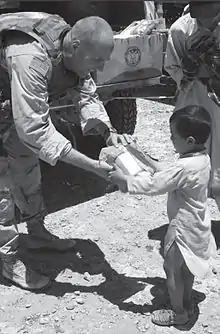Kit Parker
Kevin Kit Parker is a lieutenant colonel in the United States Army Reserve [1] and the Tarr Family Professor of Bioengineering and Applied Physics at Harvard University.[2] His research includes cardiac cell biology and tissue engineering, traumatic brain injury, and biological applications of micro- and nanotechnologies. Additional work in his laboratory has included fashion design, marine biology, and the application of counterinsurgency methods to countering transnational organized crime.[3]
Kevin Kit Parker | |
|---|---|
 Captain Kit Parker hands out a hygiene pack to a boy in Kandahar Province, Afghanistan (2007 or earlier). | |
| Service/ | United States Army Reserve |
| Rank | Lieutenant colonel |
| Other work | Faculty at Wyss Institute for Biologically Inspired Engineering, Harvard University |
| Website | diseasebiophysics |
Early life and education
Parker attended Boston University's College of Engineering and graduated in 1989. He earned a Master of Science degree in 1993 and a doctoral degree in applied physics in 1998 from Vanderbilt University.[4][5]
Military career
Parker is a paratrooper who has served in the United States Army since 1992. After the September 11 attacks, he served two tours of duty in Afghanistan.[6]
In addition to his combat tours, Parker conducted two missions into Afghanistan as part of the Gray Team in 2011.[7][8]
Civilian career
Initially, at Harvard the focus of his research was heart muscle cells. He turned to traumatic brain injury in 2005 after realizing that an Army friend of his, who had received injuries in an IED blast in Iraq in 2005, was suffering from an undiagnosed medical condition rather than a psychological problem.[9][10]
Other research of Parker's includes designing camouflage using skin cells of cuttlefish and the use of a cotton candy machine to make dressings for wounds.[11]
Parker served on the Defense Science Research Council for nearly a decade,[12] the Defense Science Board Task Force on Autonomy, and has consulted to other US government agencies as well as the medical device and pharma industry.
In 2011, Parker headed Harvard's committee for reintroducing ROTC at the university.[13]
In July 2016, it was announced that The Disease Biophysics Group at Harvard, led by Kit Parker, created a tissue-engineered soft-robotic ray that swims using wave-like fin motions, and turns according to externally applied light cues.[14]
C3 course scandal
In January 2021, students at the Harvard School of Engineering and Applied Sciences created a petition objecting to Parker's course on C3 policing. Titled "ENG-SCI 298R: Data Fusion in Complex Systems: A Case Study," the course promised to engage graduate student researchers to analyze the efficacy of a C3 techniques in Springfield, MA. The petition objected to the lack of analysis of structural racism, political economy, inequity in criminal justice, residential segregation resulting from the practice of C3, and the failure of C3 in light of repeated investigations into use of excessive force in the Springfield Police Department.[15]
Signatories demanded cancelling the class and a wide variety of other actions, including "a full independent, third-party review of Prof. Kit Parker,"[16] to determine if the he should be disciplined for unethically offering a course about policing that was not centered on its oppression of and violence against persons of color, and a demand that the university's engineering faculty be properly educated in the doctrine of police abolition.[17]
The dean of the engineering school soon announced the class was cancelled,[18] and committed to reviewing the process of vetting class offerings.[19]
Awards
References
- "Learning to Engineer a Better Brisket". The New York Times. 19 July 2015.
- Dwortzan, Mark (28 November 2012). "Professor and Paratrooper: ENG alum pinpoints cause of traumatic brain injury". BU Today. Boston University. Retrieved 8 June 2016.
- "Kit Parker". Harvard University.
- "Professor and Paratrooper - BU Today - Boston University".
- "Kit Parker". 14 July 2016.
- "Le Laboratoire Cambridge - Art and Design Center".
- "How A Team Of Elite Doctors Changed The Military's Stance On Brain Trauma".
- Science, American Association for the Advancement of (6 January 2012). "News this Week". 335 (6064): 18 – via science.sciencemag.org. Cite journal requires
|journal=(help) - Hamilton, Jon (8 June 2016). "Shots: An Army Buddy's Call For Help Sends A Scientist On A Brain Injury Quest". NPR. Retrieved 8 June 2016.
- Alexander, Caroline (February 2015). "Blast Force: The Invisible War on the Brain". National Geographic magazine.
- "Where science meets war: Kit Parker's lab". CBS News. 4 August 2013. Retrieved 8 June 2016.
- "Kevin Kit Parker, Ph.D." 5 August 2016.
- Khadaroo, Stacy Teicher (30 March 2011). "ROTC returns to Harvard: Does officer training program need Ivy League?". Christian Science Monitor. Retrieved 10 June 2016.
- "Living Soft Robots « SEAS DBG".
- "Joint Letter & Demands to Harvard SEAS regarding ENG-SCI 298r". Google Docs. Retrieved 2021-02-01.
- "Joint Letter & Demands to Harvard SEAS regarding ENG-SCI 298r". Google Docs. Retrieved 2021-02-01.
- "Joint Letter & Demands to Harvard SEAS regarding ENG-SCI 298r". Google Docs. Retrieved 2021-02-01.
- "Harvard Cancels Course On Policing Techniques After Uproar". News. 2021-01-26. Retrieved 2021-02-01.
- "Harvard calls off course amid petition campaign". www.insidehighered.com. Retrieved 2021-02-01.
- "Kevin Kit Parker - Harvard - Belfer Center for Science and International Affairs".
External links
- Kit Parker at Harvard